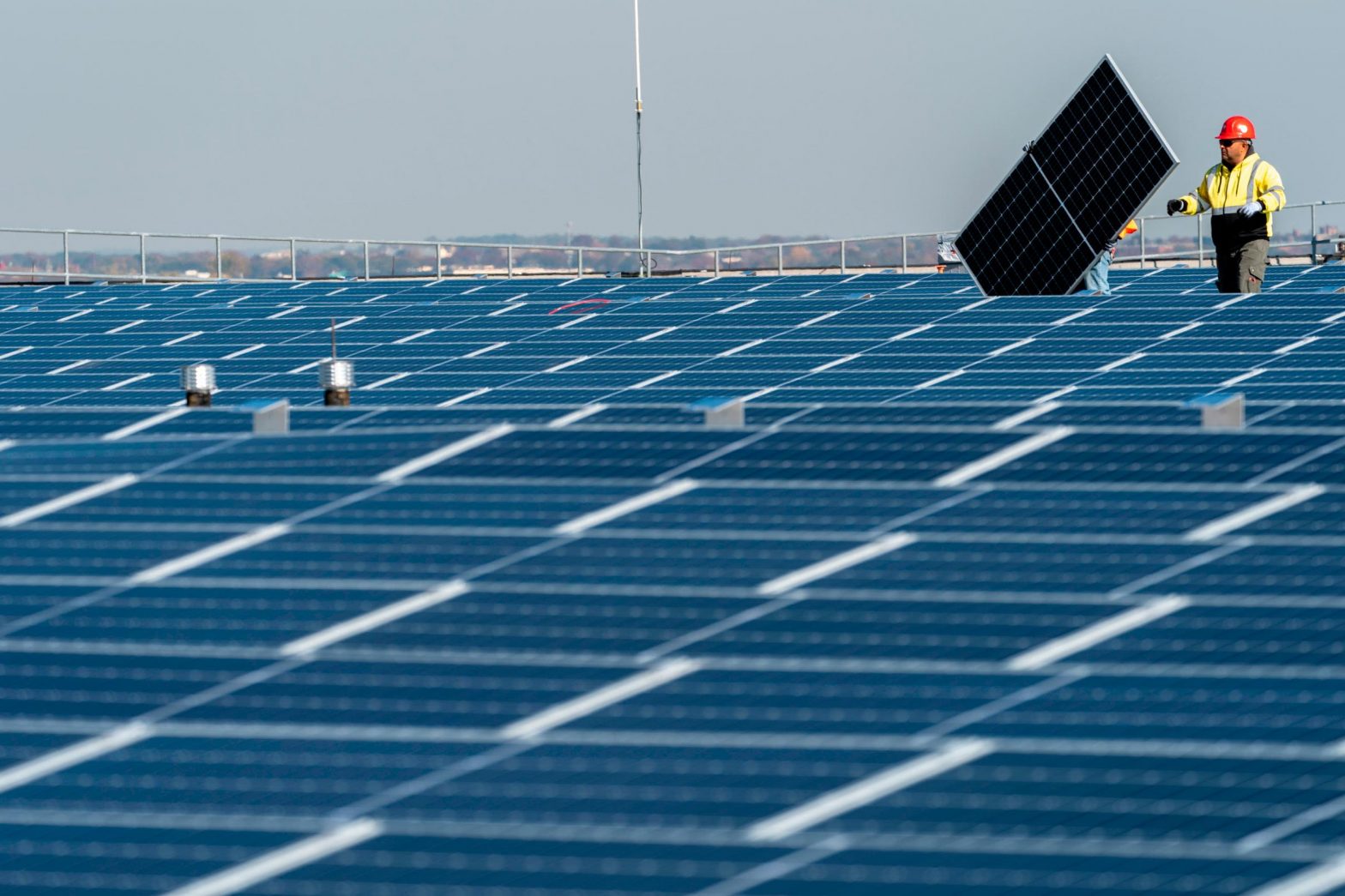As the world transitions towards renewable energy sources, wind, and solar power, as discussed by CanBio, have emerged as prominent contenders to meet our growing energy demands. When considering the affordability of these two renewable options, a common question arises: Is wind energy cheaper than solar?
This article will delve into the comparative costs of wind and solar energy, analyzing government and educational sources’ data to provide an informed perspective.
Understanding Wind Energy

Wind energy harnesses the power of the wind to generate electricity through wind turbines. It is a mature and well-established technology with a significant global capacity. According to the Global Wind Energy Council (GWEC), the cumulative installed wind power capacity will reach 743 gigawatts (GW) by the end of 2021. Wind energy offers a clean and renewable alternative to fossil fuels, reducing greenhouse gas emissions and dependence on non-renewable resources.
In comparison to solar power, wind energy has certain advantages. While solar capacity has also been multiplying, wind power can be generated even during non-daylight hours, ensuring a more consistent energy supply. Additionally, wind energy is cost-competitive with natural gas and coal, making it an attractive option for electricity generation.
By capitalizing on the vast wind resources available worldwide, wind energy has the potential to play a significant role in the transition to a sustainable and low-carbon future. Continued advancements in wind turbine technology and supportive policies will further enhance the viability and affordability of wind power as we move away from traditional fossil fuel-based energy sources.
Cost Factors in Wind Energy
Installation Costs
The upfront installation costs for wind farms include turbine manufacturing, site preparation, foundations, and transmission infrastructure. Project scale, location, turbine size, and local regulations influence these expenses. Unlike wind turbines, solar power systems primarily install solar panels, inverters, and mounting structures, resulting in different cost considerations.
While both solar and wind power offer renewable alternatives to fossil fuels and contribute to reducing greenhouse gas emissions, the specific installation costs can vary. As the global capacity for solar power continues to expand, technological advancements and economies of scale have made solar energy more cost-effective. Understanding these installation costs is essential for assessing the feasibility and competitiveness of solar and wind power compared to conventional energy sources like natural gas.
Operational Costs
Operational costs for wind farms encompass maintenance, repair, and monitoring activities. Regular maintenance is crucial to optimize the efficiency and performance of wind turbines. Unlike conventional energy sources such as natural gas or coal, wind turbines release no harmful emissions during operation. It, coupled with the abundance of wind as a renewable resource, contributes to their appeal as a cleaner and more efficient power source.
Additionally, technological advancements have made wind turbines more reliable and efficient, reducing operational costs. Comparatively, solar capacity requires minimal maintenance, focusing on panel cleanliness and efficiency. Overall, understanding the operating costs of wind turbines allows for a comprehensive evaluation of their long-term viability. Furthermore, it also provides cost-effectiveness compared to other energy sources.
Comparative Costs of Wind Energy
According to a report by the International Renewable Energy Agency(IRENA) published in 2020, onshore wind energy stands out as one of the most cost-competitive renewable energy sources available. Over the years, onshore wind projects have experienced significant cost reductions. The levelized cost of electricity (LCOE), which reflects the lifetime cost of generating electricity, has witnessed a remarkable decrease of around 40% between 2010 and 2019.
IRENA’s analysis further indicates that the global weighted average onshore wind LCOE reached approximately USD 50 per megawatt-hour (MWh) in 2019. Wind energy is priced competitively with conventional energy sources such as coal, gas, and nuclear power. Specific onshore wind projects have achieved even lower LCOEs, typically between USD 30 and USD 60 per MWh.
Technological advancements, economies of scale, and the ability to harness abundant wind resources primarily drive the cost-competitiveness of onshore wind energy. With its ability to generate mechanical power and contribute to the clean energy transition, onshore wind continues to gain traction as a cost-effective solution for meeting electricity demand while reducing carbon emissions.
Understanding Solar Energy
Solar energy, or photovoltaic (PV) energy, directly converts sunlight into electricity using solar panels. Solar power has witnessed remarkable growth in recent years. Declining costs, technological advancements, and supportive government policies fuel it. The International Energy Agency (IEA) reports that the global installed solar PV capacity surpassed 773 GW by the end of 2020.
Several factors can contribute to solar energy’s rise in popularity. Firstly, the declining costs of solar panels have made solar power more affordable and accessible. Technological advancements have significantly increased the efficiency and performance of solar panels, allowing for better electricity generation from sunlight. Additionally, governments worldwide have implemented supportive policies, including financial incentives and feed-in tariffs, to encourage solar energy adoption.
The increasing solar capacity has significantly reduced carbon emissions and a more diversified energy mix. Solar energy provides a clean and renewable alternative to fossil fuels, contributing to the global transition towards sustainable and low-carbon energy systems. As solar technology advances and costs decline, people expect solar power to play an increasingly prominent role. They hope it meets our energy needs while mitigating the impacts of climate change.
Cost Factors in Solar Energy
Installation Costs
Solar installation costs include solar panels, inverters, mounting structures, electrical wiring, and installation labor. The total installation costs can vary depending on factors such as the size of the system, panel efficiency, installation complexity, and regional labor rates. Factors like larger system sizes and higher panel efficiencies generally lead to higher upfront costs.
However, technological advancements and economies of scale have significantly reduced solar installation costs, making solar energy more accessible and cost-effective. Understanding these installation costs is essential for assessing the feasibility and affordability of solar power systems and comparing them to other energy sources. By analyzing the specific components and factors involved in the installation process, it becomes possible to make informed decisions regarding solar energy adoption.
Operational Costs
Solar energy systems generally have low operational costs, mainly focused on maintaining the cleanliness and efficiency of the solar panels. They may require occasional inspections, cleaning, and repairs, resulting in lower operational expenses than wind energy. Unlike wind turbines requiring regular maintenance, solar panels are relatively low-maintenance and have fewer mechanical components.
The simplicity of solar energy systems contributes to their long-term cost-effectiveness. With minimal operational costs, solar energy remains an attractive option for generating electricity, providing a sustainable and low-maintenance solution for meeting energy needs. Understanding the operating costs of solar energy makes it clear what solar power offers. It offers both environmental and economic advantages regarding long-term affordability and efficiency.
Comparative Costs of Solar Energy
The costs associated with solar energy have also witnessed substantial declines over the past decade. The IRENA report mentioned earlier indicates that the global weighted average LCOE for utility-scale solar PV projects fell by almost 82% between 2010 and 2019. In 2019, the average LCOE for solar PV projects was approximately USD 60 per MWh.
Solar energy costs have seen remarkable progress due to technological advancements, increased manufacturing efficiency, economies of scale, and favorable policies. Additionally, the declining costs of solar PV modules, the primary cost component of solar systems, have significantly contributed to the cost competitiveness of solar energy.
Comparing Wind and Solar Costs
When comparing the costs of wind and solar energy, one should take into account several factors:
Resource Availability
The cost-effectiveness of wind and solar energy relies on the availability of natural resources at a given location. Areas with consistent wind patterns are well-suited for wind energy generation, while regions with abundant sunlight are ideal for solar energy. Evaluating resource availability is crucial in determining the feasibility and economic viability of wind or solar projects.
By harnessing the most abundant and reliable renewable energy resource in a specific location, we can maximize the cost-effectiveness and sustainability of our energy systems. Understanding resource availability helps make informed decisions when considering the implementation of wind or solar energy solutions.
Project Scale
The scale and capacity of wind and solar projects play a significant role in determining their overall costs. Larger installations often enjoy economies of scale, reducing costs per unit of electricity generated. By increasing the size of wind or solar projects, developers can take advantage of manufacturing, installation, and operation efficiencies.
It results in lower costs and improved cost-effectiveness of renewable energy generation. Understanding the impact of project scale on costs helps in planning and implementing efficient and economically viable wind and solar projects that contribute to the transition toward a more sustainable energy future.
Geographical Factors
Various geographical factors can influence the costs of wind and solar projects. Land prices, availability of transmission infrastructure, and regulatory requirements vary from region to region, impacting the overall cost competitiveness. Higher land prices can increase the upfront costs of project development, while inadequate transmission infrastructure may require additional investments.
Moreover, varying regulatory frameworks and permitting processes can introduce additional expenses and complexities. Considering these geographical factors is essential for accurately assessing the costs and feasibility of wind and solar projects in different locations, ensuring optimal deployment and cost-effectiveness of renewable energy initiatives.
Technological Advancements

Continuous advancements in wind turbine and solar panel technologies have significantly reduced costs. Research and development efforts have improved efficiency, durability, and affordability, enhancing the overall cost competitiveness of both wind and solar energy. Increasing efficiency means generating more electricity with fewer resources, leading to lower costs per unit of energy produced.
These technological advancements have played a crucial role in making wind and solar energy more economically viable and attractive alternatives to traditional energy sources. By leveraging ongoing innovations, the renewable energy sector continues to push the boundaries of affordability and sustainability, paving the way for a greener and more cost-effective future.
Conclusion
Determining whether wind energy is cheaper than solar energy requires a comprehensive assessment of various factors. While wind and solar power have experienced significant cost reductions in recent years, the comparative costs vary depending on location, resource availability, project scale, and technological advancements.
Generally, onshore wind energy has achieved lower LCOEs compared to solar power. However, it is crucial to emphasize that the cost competitiveness of wind and solar can vary depending on specific circumstances. Therefore, one should evaluate the feasibility and cost-effectiveness of renewable energy projects on a case-by-case basis. One should consider local factors and conduct detailed economic analyses.
As the world transitions towards a sustainable energy future, wind and solar energy play vital roles in diversifying the energy mix and reducing greenhouse gas emissions. By capitalizing on their strengths and identifying synergies between them, we can maximize the benefits of renewable energy. In addition, we can accelerate the global transition to a greener and more sustainable future.



